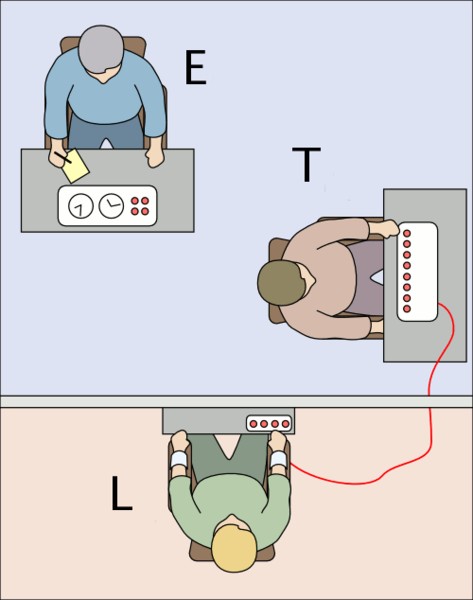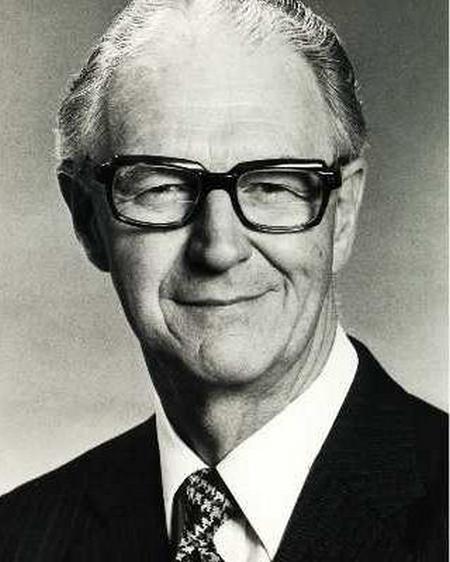Magicians, hypnotists and needy women aren’t the only ones who enjoy playing mind games. Scientists quite like to screw with our heads too and over the years they’ve found some pretty strange ways of doing just that.

Link
1. Social Laziness
In 1883 French agronomist Max Ringelmann undertook an experiment at Grandjouan Agricultural College, which showed that working in groups, actually makes us lazier.
This experiment entailed asking a group of people to tug on a rope both individually and as a team. An instrument attached to the base of the rope measured the force of their pull. The results showed that the subjects pulled harder when on their own and shirked when working in a group. The larger the group, the lazier the subjects got. In a group of eight people each person only pulled half as hard as they had before. This is proof that people are lazier when nobody’s looking.
Link
2. Thinking Outside the Box
Here’s a puzzle for you to try at home. In front of you are three small boxes. One contains a small candle. One contains matches. The other contains some drawing pins. Your challenge is to attach the candles to a door at eye level. Don’t ask why, it’s just a game.
How did you do? Of course the answer is to pin one of the boxes to the door and use it as a candleholder. However, when German psychologist Karl Duncker asked his test subjects to complete this challenge only three out of seven were able. In an alternate experiment he placed the objects outside of the boxes. In this instance all of the test subjects found the answer easily.
The purpose of Dunker’s experiment was to understand how we think creatively and how we perceive the functions of certain objects. When the boxes were used to contain other objects, they were seen as being containers only and it was more difficult for the test subjects to ‘disengage them from their original function’ and to imagine them in the new role of candleholder. However, although it’s interesting, this test has only ever been useful to Blue Peter presenters.

3. Sleep Deprivation
Experiments into the effects of sleep deprivation began as early as 1894 when cold-hearted Russian scientist Maria Manaceine kept four puppies awake long enough to kill them. The first of the puppies died after 96 hours without sleep and the last after 143 hours. Not content with killing just four puppies she then tried the experiment again, this time with six puppies. They all died. What a bitch.
The following year three men stayed awake for a period of 90 hours under the observation of scientists at the university of Iowa. They began to experience hallucinations after only the second night of wakefulness. After their 90 hour ordeal was over they then fell into such a deep sleep that even strong electric shocks could not stir them.

4. Subliminal Imagery
Early experiments into the power of subliminal imagery have themselves burned a mark on the retina of the public consciousness, particularly in America where commercialism is at it’s height. The idea of subliminal imagery was made public in 1957 when a market researcher by the name of James Vicary invited a cinema full of journalists to watch a short film about fish. The experiment has since entered popular folklore but this is no urban myth. During the short film the journalists gorged themselves on popcorn and soft drinks as the film had secretly instructed them to do. The messages ‘drink coke’ and ‘eat popcorn’ had appeared on the screen consecutively for periods lasting only 1/300th of a second each. In a previous experiment, conducted on the cinema goers of Fort Lee, New Jersey over a period of six weeks, sales of Coca-Cola rose by 18.1% and those of popcorn by 57.5%

5. The Milgram Experiment
This is one of the most shocking experiments ever conducted, quite literally. Each round of testing involved two members of the public, who had agreed to take part in the experiment with no prior knowledge of what it would entail. After meeting each other briefly and drawing lots, the two subjects were taken to two separate rooms. One was strapped into an electric chair and told to expect electric shocks at a level that would be painful but that would not cause any injury. The second subject, meanwhile, was taken to a separate room where he assumed the role of the ‘Interrogator’. The interrogator was seated in front of a microphone and an ominous looking control panel with a voltage meter attached. He was instructed to read out several multiple choice questions and await an answer via the control panel (the other subject would answer by pushing buttons). A wrong answer would result in an electric shock, to be administered by the ‘interrogator’ via the control panel. Each time the voltage of the shock would be increased. Little did those people in the role of ‘interrogator’ realize that it was they who were being studied here.
The tests began and, after several wrong answers, the voltage of the electric shock quickly reached painful levels. This might sound like fun for the interrogator but before too long they begun to hear their victims screaming in pain in the next room. At this point, interrogators frequently turned to the laboratory technicians standing behind them and asked if their counterpart was all right. The technicians simply stated that ‘the experiment requires that you continue’. Most did.
After several minutes, enough wrong answers had usually been given to cause the voltage of the shocks to increase to over 375 volts, pushing the needle on the control panel into a red area marked ‘Danger: Severe Shock.’ At this point one ‘victim’ was famously heard shouting that he wouldn’t take part anymore and refused to answer any more questions. The interrogator in this instance, a social worker by the name of Braverman was told that a non-answer should be regarded as an incorrect answer and that the shock should be delivered all the same. The victim fell completely silent and Braverman continued the test, delivering shocks as high as 450 volts.
Over one thousand subjects took part in Milgram’s experiments during the 1960s. Two thirds of them went as far as delivering a 450 volt shock. Milgram had proven that large numbers of the American public were not only capable, but also willing to torture each other simply because they had been told to do so. The ‘interrogators’ could have discontinued the test at any time. This demonstrated just how easily atrocities such as mass torture and genocide could be committed.

6. The Truth About Beards
In almost every culture around the world a finely sculpted arrangement of facial hair is recognized as a sign of wisdom. We are taught that a man with a fine beard is to be respected and revered. But does a hairy chin-warmer really alter the way we react to a person? Research has proven that the link between beards and wisdom is little more than wishful thinking by those who choose to wear a hanging chandelier of face-fluff.
Professor Jurgen Klapprotte conducted a simple experiment at the University of Nuremberg-Erlangen. He had lecturers wear beards at the beginning of one semester and go clean-shaven at the start of the next. Within ten minutes of the students having seen their new look the lecturers handed out a questionnaire about his personality. The results showed that the students thought much less of the lecturers when they were sporting beards, saying that they were ‘less focused, less friendly, less able, less rational and even less intelligent.’

7. Christ in Triplicate
Have you ever wondered what would happen if you put three people who all claimed to be God in the same room with one and other? No it’s not like in terminator when you touch your past or future self – the universe won’t collapse in on itself. In fact when psychologist Milton Rokeach did exactly that, back in 1959, very little did happen besides god getting very confused, all three of him that is.
Of course the three lunatics weren’t all God, that would just be silly. One claimed to be God, another claimed to have made God (and that this was clearly documented on his birth certificate). The third claimed to be none other than Jesus of Nazareth, although he was of no relation to the men claiming to be his father and grandfather (in fact he’d never met them before).
The point of this experiment was to discover what would happen when the men were confronted with the apparent paradox. Would it cause them to question their identities and lead them to a cure? It had happened before. Two Jesuses had met in a lunatic asylum and cured each other, the same had happened with two Virgin Marys (although you’d think they’d realize that one of them could still be the real thing). Unfortunately, none of the three generations of God that Rokeach introduced to one another were cured by the experience. One later decided to change his name to Dr Righteous Idealed Dung, much to the consternation of his wife, who was a figment of his imagination. Rokeach then began sending letters to R.I Dung under his imaginary wife’s name. In these letters the imagined Mrs Dung insisted that it was she who was the one true God. R.I Dung decided that it was best to agree with her.
The other two men were never cured of their identity problem. They were perfectly happy to live in peace with one and other, despite their obvious philosophical differences.

8. Programming Poor Little Albert
Anyone who has read Aldous Huxley’s ‘Brave New World’ will be familiar with the idea of infant ‘conditioning’. However the idea dates back to the 1920s when the Psychologist John B. Watson began teaching a nine month old infant named ‘Albert B’ to fear rats. This was achieved by making a loud and frightening noise whenever the rat was nearby. This was directly inspired by Pavlov’s experiments with dogs, in which the dogs salivated when they heard a bell, having learned to associate the bell with food. Unfortunately, little Albert was so traumatized that he began to fear anything fury, including blankets and various animals. It’s not known exactly what happened to Albert after this study but it’s fair to assume that he grew to be a very nervous adult as Watson had no way of ‘deprogramming’ the child.
The technique known as ‘conditioning’, as discovered by Pavlov and his salivating dogs has also been used by Frederic Skinner to train animals to perform amazingly complex tasks. By associating certain actions with food he trained rats to play keyboards and taught pigeons to play ping-pong.

9. Mind Over Matter
The idea of telepathic control over matter has long been associated with the paranormal and ignored by science. However over the past century there have been a number of experiments which aimed to prove once and for all that it is possible to control objects using the power of the mind. These have included using groups of volunteers to concentrate on a particular outcome of an entirely random event, such as flipping a coin. These experiments have shown a surprising degree of success but have never been entirely conclusive.
More recently, however, one Professor Moddel attempted to use will power to influence light. In 2007 he aimed a beam of light at a glass slide and asked his test-subjects to mentally increase the amount of reflected light. Amazingly, the subjects were able to successfully increase the reflection of the beam by 0.005 percent and showed a similar success when asked to mentally decrease the amount of reflected light.

10. The Powers of Belief and Ignorance
Arthur Ellison, a Professor of Electrical Engineering at the City University of London, is known for his sense of humour. His mock experiment into the power of the human mind was little more than a hoax but highlighted the amazing twin powers of belief and ignorance.
Ellison invited a group of volunteers to attempt to make a bowl of flowers levitate. They were asked to concentrate on the object and played an audio recording of chanting Buddhist monks. To their surprise the bowl lifted off the table. The experiment was rigged and the levitation was caused by powerful electromagnets (the chanting was used solely to cover the humming sound they made).
What was most interesting about this experiment, however, was the reaction of the unsuspecting participants. One old woman said that she had seen a grey substance supporting the bowl of flowers as it lifted. Presumably she imagined this to be some strange, mystical force. It is possible that she was so desperate to believe that events had been paranormal in nature that she had imagined a supernatural force to have been present. Another woman, however, reacted entirely differently. As a professor of physics she was rightly skeptical but to the point where her judgment was clouded, saying that she didn’t even see the bowl of flowers move. It quite clearly had moved, but her refusal to believe it had blinded her to the fact. She said ‘I don’t see what all the fuss is about. Nothing moved at all.’

Written by Mark Ball – Copyrighted © www.weirdworm.net







